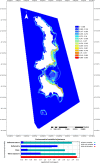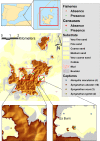A multidisciplinary approach to identify priority areas for the monitoring of a vulnerable family of fishes in Spanish Marine National Parks
- PMID: 33514312
- PMCID: PMC7853308
- DOI: 10.1186/s12862-020-01743-z
A multidisciplinary approach to identify priority areas for the monitoring of a vulnerable family of fishes in Spanish Marine National Parks
Abstract
Background: Syngnathid fishes (Actinopterygii, Syngnathidae) are flagship species strongly associated with seaweed and seagrass habitats. Seahorses and pipefishes are highly vulnerable to anthropogenic and environmental disturbances, but most species are currently Data Deficient according to the IUCN (2019), requiring more biological and ecological research. This study provides the first insights into syngnathid populations in the two marine Spanish National Parks (PNIA-Atlantic- and PNAC-Mediterranean). Fishes were collected periodically, marked, morphologically identified, analysed for size, weight, sex and sexual maturity, and sampled for stable isotope and genetic identification. Due the scarcity of previous information, habitat characteristics were also assessed in PNIA.
Results: Syngnathid diversity and abundance were low, with two species identified in PNIA (Hippocampus guttulatus and Syngnathus acus) and four in PNAC (S. abaster, S. acus, S. typhle and Nerophis maculatus). Syngnathids from both National Parks (NP) differed isotopically, with much lower δ15N in PNAC than in PNIA. The dominant species were S. abaster in PNAC and S. acus in PNIA. Syngnathids preferred less exposed sites in macroalgal assemblages in PNIA and Cymodocea meadows in PNAC. The occurrence of very large specimens, the absence of small-medium sizes and the isotopic comparison with a nearby population suggest that the population of Syngnathus acus (the dominant syngnathid in PNIA) mainly comprised breeders that migrate seasonally. Mitochondrial cytochrome b sequence variants were detected for H. guttulatus, S. acus, and S. abaster, and a novel 16S rDNA haplotype was obtained in N. maculatus. Our data suggest the presence of a cryptic divergent mitochondrial lineage of Syngnathus abaster species in PNAC.
Conclusions: This is the first multidisciplinary approach to the study of syngnathids in Spanish marine NPs. Habitat preferences and population characteristics in both NPs differed. Further studies are needed to assess the occurrence of a species complex for S. abaster, discarding potential misidentifications of genus Syngnathus in PNAC, and evaluate migratory events in PNIA. We propose several preferential sites in both NPs for future monitoring of syngnathid populations and some recommendations for their conservation.
Keywords: Conservation; Genetic identification; Habitat; National park; Stable isotopes; Syngnathids.
Conflict of interest statement
The authors declare that they have no competing interests.
Figures







References
-
- Álvarez I, de Castro M, Gómez-Gesteira M, Prego R. Inter- and intra-annual analysis of the salinity and temperature evolution in the Galician Rías Baixas-ocean boundary (northwest Spain) J Geophys Res. 2005 doi: 10.1029/2004JC002504. - DOI
-
- Álvarez-Iglesias P, Rubio B, Pérez-Arlucea M. Reliability of subtidal sediments as geochemical recorders of pollution inputs: San Simón Bay (Ría de Vigo, NW Spain) Estuar Coast Shelf Sci. 2006;70:507–521. doi: 10.1016/j.ecss.2006.07.001. - DOI
-
- Álvarez-Salgado X, Gago J, Míguez BM, Gil-Coto M, Pérez FF. Surface waters of the NW Iberian margin: upwelling on the shelf versus outwelling of upwelled waters from the Rías Baixas. Estuar Coast Shelf Sci. 2000;51:821–837. doi: 10.1006/ecss.2000.0714. - DOI
-
- Amengual-Ramis JF, Vázquez-Archdale M, Cánovas-Pérez C, Morales-Nin B. The artisanal fishery of the spiny lobster (Palinurus elephas) in Cabrera National Park, Spain: comparative study on traditional and modern traps with trammel nets. Fish Res. 2016;179:23–32. doi: 10.1016/j.fishres.2016.01.022. - DOI
-
- Anonymous. Uova, larve e stadi giovanili di teleostei. In: Fauna e flora del Golfo di Napoli. Monografia 38, Puntata 3. Stazione Zoologica di Napoli; 1956. p. 385–1064.
Publication types
MeSH terms
LinkOut - more resources
Full Text Sources
Other Literature Sources
Miscellaneous
